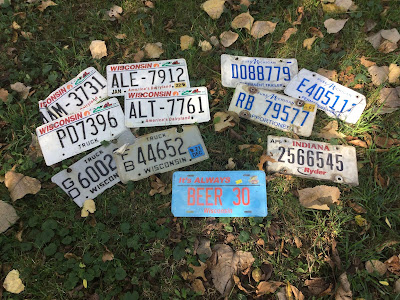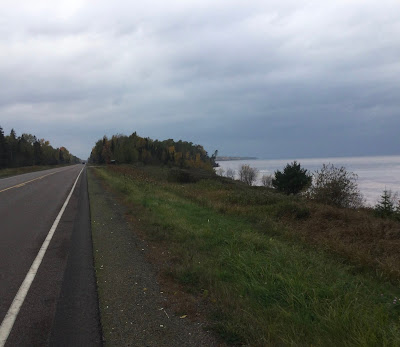Even though the MacDonald’s was adequately staffed to have indoor service, it still had a “Hiring” sign out front, though not with a bonus as many businesses offer, as much as $1000. All the ‘Hiring” signs dominated the landscape from the start to the finish of these travels.
I was looking forward to the luxury of relaxing on the train, gazing out at the scenery, spared of having to negotiate the miles and miles of urban sprawl traffic and regular red lights in the final fifty miles home. I was already dreading the transition from simple, functional small town homes to the pretentious and ostentatious and all-too-big homes of suburbia. There was little evidence of people in small towns trying to outdo or upstage their neighbors, except maybe with their Halloween decorations. The homes all look lived-in and livable and could be maintained without a crew of Mexican gardeners and Polish maids. The were homes, not statements.
My final campsite was just past Hartford on the fringe of Kettle Moraine a little over thirty miles from Milwaukee. As is frequently the case when I have to clear a rough spot for my tent, memories of Craig and our several tours in France were triggered, as he was ultra-fastidious in smoothing out the spot he had chosen for his tent so he wouldn’t be surprised by any rocks or roots when he laid down. I’d invariably have my tent half set up while he was still grooming his site.
It’s always a pleasure to be reminded of Craig and his attention to detail and facility for figuring things out. He’s come to my rescue many a time, including earlier in the day when he pointed out I’d referred to Carnegie as a “steel magnet” not “steel magnate” in my last post.
The Craig trigger of memories is just one of many that can get set off at any time. At the end of the day Waydell and her comment after a three-day mini-tour over Thanksgiving, “I feel as if I’ve accomplished something,” often comes to mind, echoing my sentiment for the day. Bungee cords can launch Lyndon and his trick of knotting them to adjust their length. Pop tarts resurrect a messenger friend who introduced them to me as a cheap energy bar, regular fuel for me when I’m touring in the US. Apple sauce, another regular source of calories, summons a German cyclist I met one year following The Tour who filled a water bottle with the potion and regularly squirted it down his throat.
My final campsite was the coldest of the trip, the first to encrust the tent with frost. It hadn’t gotten warmer than forty-five all day and was thirty-seven when I retreated into my tent and ten degrees colder when I woke up. I burned a candle for the first time and with my body heat got the tent up to fifty degrees. I also dug out my wool cap for the first time, but resisted stripping down to put on an extra layer of long underwear. I tried to sleep with my down vest draped over my torso, but that wasn’t enough. I had to put it on along with my sweater.
I was able to supplement my final dinner of ramen with some turkey franks from an Aldi’s a couple miles from where I camped. The only other salvageable item of the meager dumpster offerings was some milk, which I could use for the last of my Cheerios. I further jazzed up my ramen with some crushed tortilla chips from a previous Aldi’s and also a few ketchup packs from the MacDonald’s. It made for a tasty stew, which tasted all the better eating it in my tent rather than in a motel.
I was hoping I hadn’t made a mistake passing up the Silver Bell Motel a few miles back in Hartford. If I hadn’t pretty much dried out all my garb other than my heavy gloves it would have been a necessity. WiFi, Thursday Night Football and a shower all beckoned, but I wanted one last night in the tent, and, besides, the Aldi’s was a couple miles past the motel on the outskirts of town. As always, I was happy I opted for the tent, even when I struggled to collapse my tent poles in the morning, as several joints had frozen as had the water bottles I left on my bike. If I’d given into the temptation of the Silver Bell I wouldn’t have had the glorious sight of a near full moon over the tent as I took it down.
There was minimal rush hour traffic heading into Milwaukee, and minimal congestion in the city. The last few miles were on Doctor Martin Luther King Junior Drive, which took me past the stadium where the NBA champs Bucks play, adorned with the faces of their starting five.
None of the eight slots for bikes on the one o’clock train had been reserved though the train was at near capacity. I spread out my frost-flecked and thickened tent to dry so I could roll it tighter to make it fit into the duffle with all my gear. The security guard came over to make sure I had a ticket and urge me to hurry with my packing. It was my lone encounter the past month with someone wearing a badge.
It was a rare trip that someone more official hadn’t questioned me in some manner. And rare too finding just one neckerchief in 2,181 miles. The license plates more than made up for it though with a record eleven and from three states. Get ready Dwight.


















































